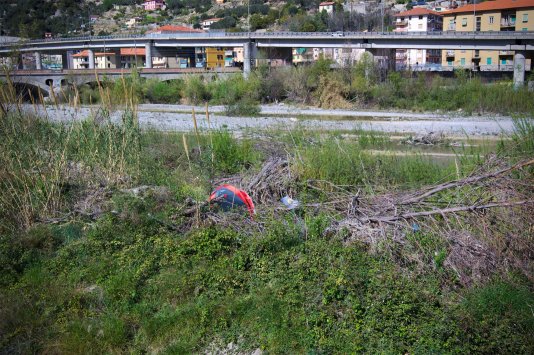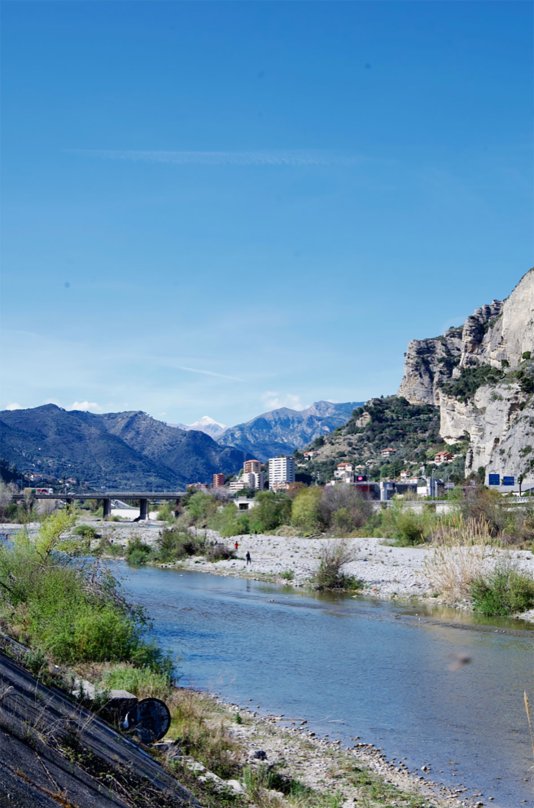- About
- Topics
- Story
- In-Depth
- Picks
- Opinion
- News
- Donate
- Signup for our newsletterOur Editors' Best Picks.Send
Read, Debate: Engage.
| February 28, 2023 | |
|---|---|
| topic: | Refugees and Asylum |
| tags: | #Italy, #clean water, #migrants |
| located: | Italy |
| by: | Lara-Nour Walton |
The Roya River oscillates - crossing from France into Italy, skirting the French frontier, before tumbling into the Italian Riviera. Its final stop before the Mediterranean Sea is Ventimiglia, Italy. The Roya slices through the belly of the coastal town and is the envy of many of its residents who wish they could cross borders just as brazenly.
In 2011, Ventimiglia was inundated with its first major influx of migrants. 26,000 Tunisians fleeing intensifying civil unrest in their homeland made their way to Italian shores, only to find themselves struggling to enter France due to stringent border controls. With the advent of Europe’s 2015 'refugee crisis,' Ventimiglia’s population swelled.
Today, it is a highly frequented transit hub, witnessing an annual estimate of 30,000 passing migrants hailing from Afghanistan, Ethiopia, Sudan, and other regions. To accommodate ballooning numbers, Ventimiglia’s Red Cross opened the Campo Roja reception centre in 2016. However, due to strict Italian COVID-19 measures, it was forced to halt its operations.
Since the shutdown, many asylum seekers resorted to living in makeshift settlements, congregating primarily on the Roya’s banks. "I brush my teeth and wash my face with this water every day," a young Tunisian told FairPlanet, gesturing at the splash of blue beneath the concrete overpass. "And," he continued with a bit of trepidation, "sometimes, I drink from it too."
This is not an uncommon experience; without consistent access to shelter, sanitation, and sustenance, 85.2 per cent of migrants report bathing and going to the bathroom in one of their only consistent drinking water sources: the Roya River.
In addition to the health risks associated with consuming water contaminated with human excrement, the Roya is visibly polluted.
Virginie Lelarge, founder of the Monaco-based environmental research institute IMEDD, studied the Roya following the October 2020 flood that washed over much of the Ligurian region. "I found many clothes that belonged to the migrants," Lelarge said. "I found needles because people drug themselves by the river. Lots of plastic bottles as well.
"This is an environmental problem, but also a problem of health because migrants live near the Roya river, go to the toilet there, drink the water."
Another concern arose when New York University and Sciences Po Menton Campus students uncovered alarming levels of E. Coli in the river. The research team was awarded a USD 10,000 grant for their 20 Miles More initiative to conduct Roya water quality tests and produce a feature-length documentary about Franco-Italian border conditions.
The river’s high E. Coli content led them to conclude that it was unsuitable for human consumption.
Furthermore, although Ventimiglia’s communal taps provide a sanitary water alternative, they flow unreliably - shutting off suddenly and for undisclosed amounts of time.
Local NGOs, the most active of which is Caritas, do not give out water in their resource distributions, providing only food, clothing and medical care.
"If people want to take a shower, they have to go to San Remo," said another Tunisian migrant. San Remo boasts a more versatile Caritas branch, but is a three-hour and 21-minute walk from Ventimiglia. Many resign to bathing in the Roya instead.
The banks of the Roya are rimmed with pebbles, tents, discarded pieces of meat and rags that may have once been clothing. Its waters would have been charming if they did not carry rusty beer cans and organic waste. Many of Ventimiglia’s unofficial migrant camps are nestled along this stretch, which they share with wild boars that often pester slumberers.
But while the river’s water serves as a lifeline for many asylum-seekers, sleeping next to it is far from desirable.
Médecins Sans Frontières described the banks as overcrowded, unhygienic and unsafe. To avoid the disagreeable conditions near the Roya, many scale the railway bridge that extends over the river and seek refuge in the structure’s cutouts.
Last year, an Algerian migrant fell from such a sleeping perch and injured his left hand severely; he extended his fingers languidly to show the extent of the damage. Even after receiving Caritas’ emergency medical attention, he can no longer do manual labour, which greatly limits his employment prospects.
A group of migrants sipping beer at a neigbourhood café told FairPlanet that the bridge sleeping arrangements are contingent on where one is from.
"People sleep in the concrete cutouts like mice. There is a hole for the Tunisians, one for the Sudanese, one for the Syrians. It’s separated by country," remarked an Algerian migrant. This statement aroused some solemn nods. "You know," he added, "the only thing we share is the river."
Ventimiglia’s train station is in the heart of the town. Cafés, all-you-can-eat sushi restaurants, and lush vegetable stands stud adjacent streets. But, keep walking, and the multi-coloured buildings invariably give into the Roya.
The river is a quintessential part of Northern Italy’s natural topography and is central to the lives of the migrants who inhabit the region. IMEDD has spearheaded the community cleanup effort, Rescue for Future, to rid the Roya of waste, but Lelarge advocates more intergovernmental cooperation. To her, climate action should have no regard for borders and galvanise all affected states into a unified response.
However, with no governments adequately addressing the sanitary crisis at the Roya, grassroots projects like Rescue for Future provide an immediate and urgent sanitation remedy. In the long term, the 20 Miles More documentary, set to premiere in 2023, seeks to counteract the ephemeral nature of river cleanups.
"Our focus ended up being placed on the documentary itself rather than momentary action that would fade away after we left," said the director Nico Romero. He hopes that the film will educate, mobilise Ventimiglia non-profits and inspire border-policy change.
Access to clean drinking water and proper sanitation - fundamental human rights recognised by the United Nations - are ongoing issues for Ventimiglia’s asylum seekers, and local initiatives have played a crucial role in raising awareness about migrants’ plight and providing support. Still, some in the area point out that more work may be needed to ensure that vulnerable communities have access to basic necessities.
This is especially true with Europe’s increasingly arid conditions threatening potable water sources. As climate change ravages the globe and portends the displacement of 1.2 billion people by 2050, the struggles of Ventimiglia’s asylum-seeker population are only harbingers of what may come.
Image by Emilia Kohlmeyer and Hugo Lagergren
By copying the embed code below, you agree to adhere to our republishing guidelines.



